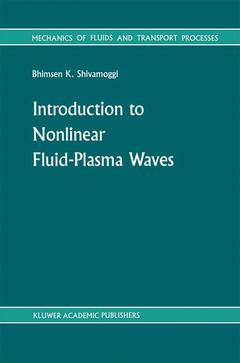Description
Introduction to Nonlinear Fluid-Plasma Waves, Softcover reprint of the original 1st ed. 1988
Mechanics of Fluids and Transport Processes Series, Vol. 8
Author: Shivamoggi B.K
Language: English
Keywords
Soliton; electromagnetic wave; electron; model; oscillation; scattering; stability; turbulence
Approximative price 105.49 €
In Print (Delivery period: 15 days).
Add to cart
Publication date: 09-2011
202 p. · 15.5x23.5 cm · Paperback
202 p. · 15.5x23.5 cm · Paperback
Description
/li>Contents
/li>
A variety of nonlinear effects occur in a plasma. First, there are the wave steepening effects which can occur in any fluid in which the propagation speed depends upon the wave-amplitude. In a dispersive medium this can lead to classes of nonlinear waves which may have stationary solutions like solitons and shocks. Because the plasma also acts like an inherently nonlinear dielectric resonant interactions among waves lead to exchange of energy among them. Further, an electromagnetic wave interacting with a plasma may parametrically excite other waves in the plasma. A large-amplitude Langmuir wave undergoes a modulational instability which arises through local depressions in plasma density and the corresponding increases in the energy density of the wave electric field. Whereas a field collapse occurs in two and three dimensions, in a one-dimensional case, spatially localized stationary field structures called Langmuir solitons can result. Many other plasma waves like upper-hybrid waves, lower-hybrid waves etc. can also undergo a modulational instability and produce localized field structures. A new type of nonlinear effect comes into play when an electromagnetic wave propagating through a plasma is strong enough to drive the electrons to relativistic speeds. This leads to a propagation of an electromagnetic wave in a normally overdense plasma, and the coupling of the electromagnetic wave to a Langmuir wave in the plasma. The relativistic mass variation of the electrons moving in an intense electromagnetic wave can also lead to a modulational instability of the latter.
I. Introduction.- II. Nonlinear oscillations in an electron plasma.- III. Nonlinear ion-acoustic waves.- (i) Shockwaves.- (ii) Solitary waves.- (iii) Interacting solitary waves.- (iv) Ion-acoustic waves in a magnetized plasma.- IV. Parametric excitations of plasma waves.- (i) Parametric excitation of electromagnetic waves by an oscillating electric field.- (ii) Wave-wave interactions.- (a) Nonlinear resonant interactions between two electromagnetic waves and a Langmuir wave.- (b) Nonlinear resonant interactions between two transverse electromagnetic waves and an ion-acoustic wave.- (c) Nonlinear resonant interactions between two circularly-polarized waves and a Langmuir wave.- (d) Nonlinear resonant interactions between three extraordinary waves.- (e) Stimulated wave-scattering phenomena.- (f) Oscillating two-stream instability.- (g) The question of the time-dependent ponderomotive force.- V. Modulational instability and envelope solitons.- (i) Langmuir solitons.- (a) Instability and collapse of Langmuir solitons.- (b) Nearly sonic Langmuir solitons.- (c) Effect of finite spectral-width on the modulational instability of Langmuir waves.- (d) Strong Langmuir turbulence.- (ii) Modulational stability of ion-acoustic waves.- (iii) Upper-hybrid solitons.- (a) Subsonic and supersonic upper-hybrid solitons.- (b) Sonic upper-hybrid solitons.- (c) Upper-hybrid solitons in an electron plasma.- (iv) Lower-hybrid solitons.- (v) Whistler solitons.- VI. Nonlinear relativistic waves.- (i) A coupled system of an electromagnetic wave and a Langmuir wave.- (a) Purely transverse waves.- (b) Luminous waves.- (c) A perturbation theory for the general coupled system.- (ii) Nonlinear relativistic waves in a magnetized plasma.- (a) Purely transverse waves.- (b) Waves with ? ? 1.- (iii) Relativistic modulational instability of an electromagnetic wave.- VII. Nonlinear waves in an inhomogeneous plasma.- (i) Ion-acoustic solitary waves in an inhomogeneous plasma.- Appendix 1: The fluid model for a plasma.- Appendix 2: Review of linear waves.- (i) Plasma oscillations.- (ii) Ion-acoustic waves.- (iii) Waves in a magnetized plasma.- (a) Propagation along the magnetic field.- (b) Propagation transverse to the magnetic field.- References.
© 2024 LAVOISIER S.A.S.
These books may interest you

Guided-Wave-Produced Plasmas 52.74 €



